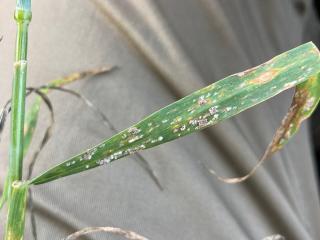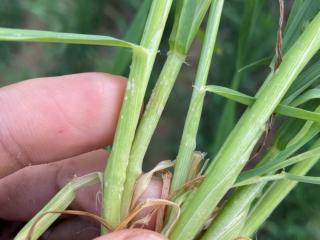Powdery mildew in barley and wheat
- Perenjori
- Wialki
- Mukinbudin
- Meckering
- Northam
Nic McKenna (Planfarm) reports finding powdery mildew in Rockstar wheat (rated MSS) in the shire of Perenjori. The crop was sown in early April and lesions are visible on the stems but not the leaves.

Dan Taylor (DKT Rural Agencies) has reported finding mature powdery mildew pustules in regrowth wheat at heading and in Scepter wheat (rated S for mildew) at the 4-6 leaf stage near Meckering. The crop had been treated with Uniform® fungicide in-furrow but this is not registered for control of mildew in wheat (although it is registered to suppress mildew in barley).
Powdery mildew has also been found in Buff barley (rated S for mildew) near Mukinbudin. Powdery mildew is also in barley crops near Northam and Wialki.
Powdery mildew has distinctive symptoms. Fluffy, white powdery growths (becoming cream-grey with age) of fungal spores can be seen on leaf surfaces. Under severe pressure later in the season it may also be present on leaf sheaths and in heads.
Powdery mildew is favoured by mild temperatures (15–22°C) and high humidity (in excess of 70%). Dense crop canopies, high nitrogen nutrition and extended periods of canopy humidity are factors that are understood to favour mildew development. Dry and warm weather conditions that result in periods of low canopy humidity and temperatures above 25°C can reduce disease development. However, hard rain can help supress mildew development.
Barley and wheat powdery mildew are host specific and do not cross infect. However these reports indicate that seasonal conditions are conducive for disease development of both mildews and so monitoring of wheat and barley crops for this and other diseases should be ongoing, particularly in areas where a pre-season green bridge was apparent or susceptible varieties have been sown.
For barley and wheat variety disease ratings, refer to the department's 2022 Crop Sowing Guide for WA. Infection early in the season on susceptible – moderately susceptible varieties can significantly reduce yield (by up to 25%) while infection at later stages (after Z39) is usually less damaging.
Seed dressing or in-furrow products applied to manage other diseases may provide some degree of protection from powdery mildew but are not registered for this use.
Registered foliar fungicides can be used to control powdery mildew infection; application early in the epidemic before significant disease (eg, first application around stem elongation) development is most effective. For more information refer to the department’s Registered foliar fungicides for cereals in Western Australia page.
Fungicide resistance
There are currently no records of fungicide resistance in wheat powdery mildew in WA. However, reports of mutations affecting Group 11 and Group 3 fungicides in eastern Australia show the need for appropriate fungicide resistance management strategies in WA.
Since 2012 barley powdery mildew in WA has exhibited resistance to some DMI fungicide products and as part of a disease resistance management strategy growers should avoid using ‘compromised’ fungicides.
The compromised triazole ingredients include: tebuconazole (resistant), flutriafol and propiconazole (reduced sensitivity). These fungicides (particularly tebuconazole) have reduced field efficacy and are not recommended for barley powdery mildew control as stand-alone products. As good practice all DMI fungicide actives should be rotated within and across seasons, repeated use of the same active ingredient will increase the selection pressure on the fungicide resistant strains of powdery mildew.
One way to reduce the resistance development of the pathogen is to use fungicide mixtures with different modes of action. Thirteen compounds from four modes of action (FRAC Code 3, 5, 7 and 11) are registered in Australia for powdery mildew control (see DPIRD’s Registered foliar fungicides for cereals in Western Australia). Fungicides containing both a strobilurin (Group 11) and an uncompromised triazole (Group 3) active ingredient such as azoxystrobin + cyproconazole (Amistar Xtra®), azoxystrobin + epoxiconazole (Radial®, Tazer Xpert®), azoxystrobin + propiconazole (TopnotchTM), pyraclostrobin + epoxiconazole (Opera®) or succinate dehydrogenase (SDHI; Group 7) base, benzovindiflupyr + propiconazole (Elatus® Ace) or prothioconazole + bixafen (Aviator® Xpro®) should have uncompromised activity against powdery mildew. Use one application per season of each of these strobilurin or SDHI based fungicide mixtures as part of a fungicide resistance management strategy within the disease control program. A powdery mildew specific multisite amine (Group 5), spiroxamine (eg. Prosper 500® EC) is also registered.
For more information refer to DPIRD’s Managing barley powdery mildew in the face of fungicide resistance page.
If you suspect fungicide resistance in your paddock then researchers at the Centre for Crop and Disease Management (CCDM) would love to hear from you. To get in touch please email CCDM’s fungicide resistance team at frg@curtin.edu.au .
For more information on powdery mildew visit DPIRD’s Diagnosing powdery mildew in cereals page and GRDC’s Barley powdery mildew fact sheet.
For more information contact Plant pathologists Kithsiri Jayasena, Albany on +61 (0)8 9892 8477, Geoff Thomas, South Perth on +61 (0)8 9368 3262 or Andrea Hills, Esperance on +61 (0)8 9083 1144 or Ciara Beard, Geraldton on +61 (0)8 9956 8504.
Article authors: Kithsiri Jayasena (DPIRD Albany), Andrea Hills (DPIRD Esperance), Geoff Thomas (DPIRD South Perth) and Ciara Beard (DPIRD Geraldton).

